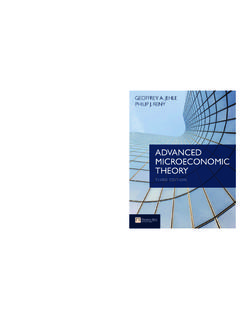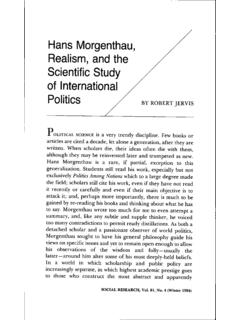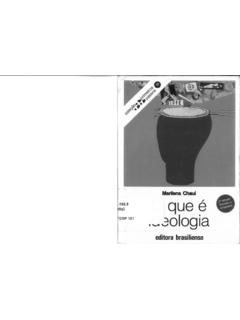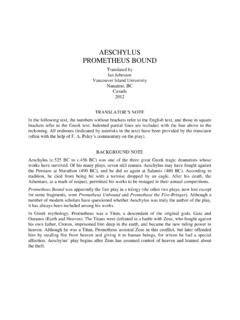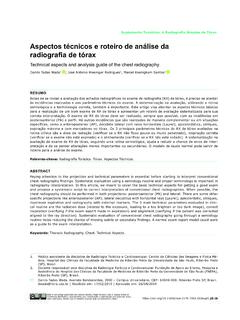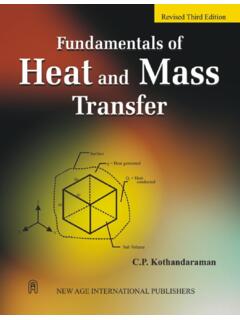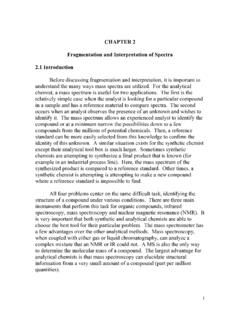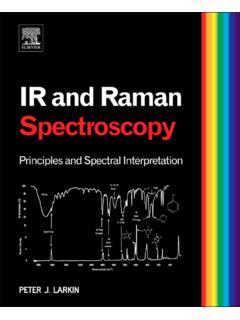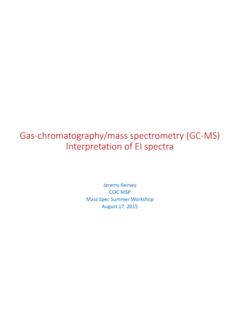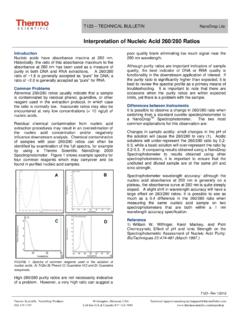Transcription of Mass Spectrometry Interpretation
1 Mass Spectrometry Interpretation MS vs NMR Absorbance aspirin EI-MS NMR MS vs. NMR MS peaks are narrower than NMR peaks MS is much more (104 x) more sensitive than NMR (among most sensitive tools) MS allows one to analyze much larger molecules (>50 kD) than NMR MS samples are more difficult to prepare MS is not particularly quantitative MS instruments cost a little less than NMR Appearance of the Spectrum molecular ion highest mass ion except for isotope peaks molecular weight Nitrogen Rule (even-odd rule)
2 Compounds with 0 or even numbers of N atoms have even molecular weights and fragments of odd mass compounds with an odd number of N atoms have odd molecular weights Interpretation of Mass Spectra Select a candidate peak for the molecular ion (M+) Examine spectrum for peak clusters of characteristic isotopic patterns Test (M+) peak candidate by searching for other peaks correspond to reasonable losses Look for characteristic low-mass fragment ions Compare spectrum to reference spectra Exact Masses ElementSymbolExact Weight Determination Compounds with nominal mass 28.
3 Exact mass Isotopic Abundance Ratios ElementM+M+1M+ Weight Determination Compounds with nominal mass 28. Isotope Clusters MM+1M+2CO100% Isotope Clusters Position Intensity 135 0% 133 0% 124 0% 123 3% 122 0% 121 30% 120 1% 119 96% 118 1% 117 100% 116 0% Fragmenta o Governada pela estabilidade do on produzido considera o regra do octeto deslocaliza o por resson ncia polarizabilidade e hiperconjuga o eletronegatividade Regra de Stevenson: Para quebra de uma liga es simples, o fragmento com o potencial de ioniza o mais baixo fica com a carga (em outras palavras, forma-se o on mais est vel) Regras Gerais de Fragmenta o Quebra de Uma Liga o (Quebras-a) Quebra de Duas Liga es Elimina o de H-X retro Diels-Alder Rearranjo de McLafferty The mass spectra of simple hydrocarbons have peaks at m/z values corresponding to the ions produced by breaking C-C bonds.
4 Peaks can occur at .. m/z 15 29 43 57 71 85 etc. CH3+ C2H5+ C3H7+ C4H9+ C5H11+ C6H13+ the stability of the carbocation formed affects its abundance the more stable the cation the higher the peak the more alkyl groups attached to the carbocation the more stable it is most stable tertiary 3 > secondary 2 > primary 1 least stable alkyl groups are electron releasing and stabilise the cation ALKANES FRAGMENTATION PATTERNS Alkane Fragmentation Long chains
5 Give homologous series of m/z = 14 units Long chains rarely lose methyl radical Straight chain alkanes give primary carbocation branched alkanes have small or absent M+ enhanced fragmentation at branch points Cycloalkanes loss of side chain loss of ethylene fragments octane CH3CH2CH2CH2CH2CH2CH2CH3m/z = 1148571574329linear alkane pattern sequential peaks 14 mass units apart isooctane CH3 CCH2 CHCH3CH3CH3CH3m/z = 114CH3 CCH3CH3CH2 CHCH3CH3 CCH2 CHCH3CH3CH3CH3CH3m/z = 57m/z = 99branched alkane - formation of most stable carbocation Alkene Fragmentation Fairly prominent M+ fragment ions of CnH2n+ and CnH2n-1+ terminal alkenes lose allyl cation if possible Cycloalkenes prominent molecular ion retro Diels-Alder cleavage 1-butene & 2-butene mass spectra are identical - not a good method for alkene isomers Alkyne Fragmentation Molecular ion readily visible terminal alkynes readily lose hydrogen atom terminal alkynes lose propargyl cation if possible Aromatic Hydrocarbon
6 Fragmentation Molecular ion usually strong alkylbenzenes cleave at benzylic carbon tropylium ion formation McLafferty rearrangement of aromatics need g-hydrogens benzene m/z = 78C6H6ei+ eclosed shell(paired electrons)open shell(odd electron ion)toluene CH3- H+C7H7tropylium ionm/z = 91m/z = 92n-propylbenzene m/z = 92+CH2 HHCH2CH2-+H+CH2CH3CH2CH2CH3- +C7H7tropylium ionm/z = 91m/z = 120isopropylbenzene m/z = 120m/z = 105- CHCH3CH3CH3 CHCH3+o-xylene m-xylene Halide Fragmentation Loss of halogen atom Elimination of HX alpha-cleavage 1,4-rearrangement chloroethane CH3CH2 ClCH3CH2 ClCH3CH2 Clm/z 64m/z 29(loss of 35)m/z 49CH2 ClCH3(lossof 15)
7 Bromoethane bromohexane m/z = 164CH3CH2CH2CH2CH2CH2Br- BrCH3CH2CH2CH2CH2CH2+85 BrBr-CH2CH3135+Alcohol Fragmentation Molecular ion strength depends on substitution primary alcohol weak M+ secondary alcohol VERY weak M+ tertiary alcohol M+ usually absent Dehydration fragmentation thermal vs. 1,4-dehydration of M+ Loss of alkyl group largest R group lost as radical 1-butanol CH3CH2CH2CH2OH74a-cleavage-CH3CH2CH2CH2O H+31-H2OC4H9+562-butanol 74a-cleavage-CH3CH2 CHOHCH3+-H2OC4H9+56CH2 CHOHCH3CH359a-cleavage-CH3CH2 CHOHCH3+45t-butanol benzyl alcohol CH2OH- HCH2O+108107-CH2O+77 OHHH-CO+HH+79o-cresol Carbonyl Compounds Dominant fragmentation pathways.
8 A-cleavage b-cleavage McLafferty rearrangement Cleavage of bonds next to the carbonyl group (C=O) is a characteristic fragmentation of aldehydes and ketones. A common fragment is carbon monoxide (CO) but as it is a molecule and thus uncharged it will not produce a peak of its own. However, it will produce an m/z drop of 28 somewhere in the spectrum. The position of the carbonyl group influences the fragmentation pattern because the molecular ion fragments either side of the carbonyl group the more stable the acylium ion RCO+, the more abundant it will be and the more abundant the species the taller its peak in the mass spectrum FRAGMENTATION PATTERNS ALDEHYDES AND KETONES The position of the carbonyl group influences the fragmentation pattern because the molecular ion fragments either side of the carbonyl group.
9 FRAGMENTATION PATTERNS Aldehydes and ketones O CH3 C C4H9 MOLECULAR ION has m/z = 100 + The position of the carbonyl group influences the fragmentation pattern because the molecular ion fragments either side of the carbonyl group. FRAGMENTATION PATTERNS Aldehydes and ketones O CH3 C C4H9 O C4H9 C+ CH3 O C4H9 C CH3+ m/z = 15 m/z = 85 MOLECULAR ION has m/z = 100 Breaking the bond between the methyl group and the carbonyl group produces two possible ions, depending on how the bond breaks.
10 Two peaks at m/z values 15 and 85 will appear in the mass spectrum. + The position of the carbonyl group influences the fragmentation pattern because the molecular ion fragments either side of the carbonyl group. FRAGMENTATION PATTERNS Aldehydes and ketones O CH3 C C4H9 O CH3 C+ C4H9 O CH3 C C4H9+ m/z = 57 m/z = 43 MOLECULAR ION has m/z = 100 + Breaking the bond between the butyl group and the carbonyl group produces two further ions, depending on how the bond breaks.
